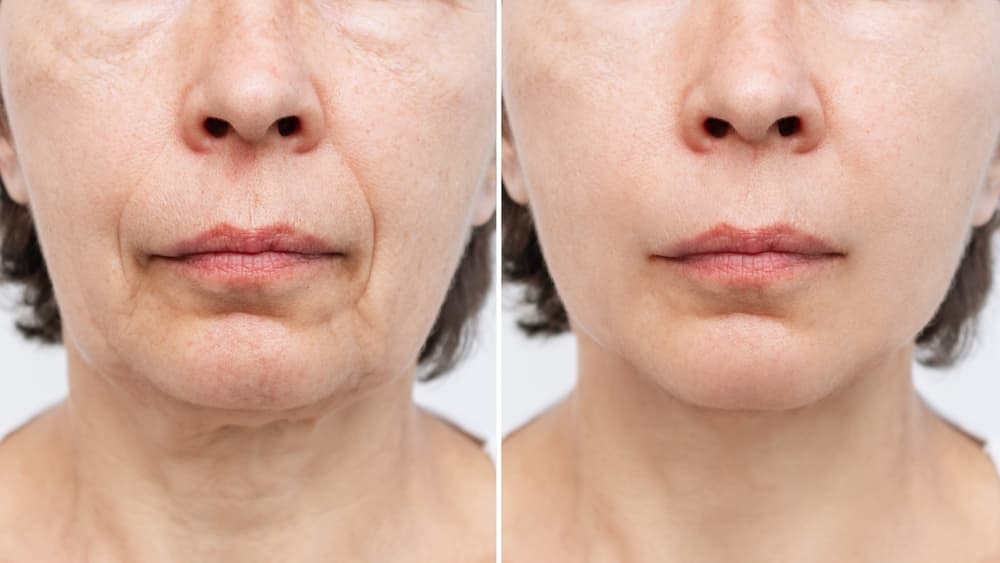A cosmetic procedure performed by a licensed board-certified plastic surgeon can greatly improve a person’s mental health and well-being. Millions of people around the world seek consultation for cosmetic surgery, whether it be to boost their self-confidence or following a traumatic injury. For those who wish to enhance the structure of their face with natural, youthful results, a muscle-supporting facelift may be recommended.
What is a muscle supporting facelift aka SMAS?
A muscle supporting facelift aka superficial muscular aponeurotic system (SMAS) is a commonly performed type of rhytidectomy (facelift). A board-certified plastic surgeon uses this cosmetic surgical procedure to address a loss of skin elasticity, skin sagging, excess fat, and a loss of volume in the cheeks within the lower two-thirds of the face.
A muscle-supporting facelift is less invasive than a traditional rhytidectomy, and is often associated with a shorter recovery time. The SMAS is the layer of tissue located within the dermis and subcutaneous tissue. Alteration of the SMAS allows for natural changes to your facial appearance without the “overdone” look.
Indications for muscle supporting facelift
As you naturally age, the epidermis (skin) loses elasticity and the SMAS membrane becomes affected. The SMAS membrane is the layer of deep tissue found within the dermis and subcutaneous tissues and is one of the most important facial structure components.
A superficial muscular aponeurotic system rhytidectomy may be recommended for those who experience:
- Skin sagging along the midfacial area
- Sagging or hollowing cheeks
- Loose skin beneath the chin and/or jawline
- Jowls or sagging skin around the neck
- Nasolabial folds
Men and women over the age of 50 years of age who wish to correct one or more signs of aging with natural, long-lasting results may be a candidate for a muscle-supporting facelift. It is important to note that SMAS rhytidectomy candidates must be healthy, non-smokers, as smoking and poor health can result in high-risk, life-threatening complications.
Benefits of a superficial muscular aponeurotic system rhytidectomy
Aside from the most obvious confidence boost that a SMAS facelift brings, a muscle supporting rhytidectomy has many benefits in comparison to a traditional facelift. With a SMAS facelift, you get a youthful, natural look through a minimally invasive surgical procedure with a shorter recovery time.
Though a traditional SMAS facelift requires incision sites and stitches, your incisions are easily hidden during a SMAS facelift where the minimal scarring is not easily detectable. Although aging cannot be completely stopped, the superficial muscular aponeurotic system facelift offers results lasting more than 10 years for most!
See some examples of our clients' before and after facelifts
What to expect with a SMAS facelift
The journey to a muscular supporting facelift will begin with a consultation with your preferred board-certified plastic surgeon including a physical examination, medical history evaluation, and an overall inquiry into your health and social activities such as alcohol consumption and smoking habits.
Once all areas have been assessed and a determination has been made that you are indeed a good candidate for SMAS rhytidectomy, you will be given all instructions to prepare for your impending surgery date.
Before surgery, your surgeon will go over the surgical procedure and what to expect before, during, and after, allowing for ample time to answer any questions or concerns you may have.
On the day of surgery, your surgical team will assess the facial structure and make markings to determine the areas that need to be cut and essentially provide a guide to ensure complete satisfaction. Once in the operating room, drapes will be placed around you and your face will be cleansed with an antiseptic solution to create a sterile surgical field. Intravenous sedation medication will be given and you will gently drift off to sleep.
Once you are safely sedated, surgery will commence and your chosen board-certified plastic surgeon will begin making cuts to the marked areas of your face. The facial tissue and muscle beneath the epidermis (skin) are lifted and excess skin is cut away, enabling your surgeon to then stitch the skin back together in a more desirable position.
Once surgery has been completed, a compressive dressing and drainage tubes will be placed, allowing excess fluid to drain from beneath the skin to ensure healing occurs properly.
How much does a muscle supporting facelift cost?
A superficial muscular aponeurotic system facelift procedure can cost on average anywhere from $10,000 to $15,000, depending on many factors including:
- Location
- Board-certified plastic surgeon
- Length and involvement of surgery
- Anesthesia costs
- Facility fees
To expound, SMAS facelift costs will vary greatly from one surgeon to the next as each board-certified plastic surgeon carries their own personalized experience and expertise. This depends on factors, such as your chosen surgeon’s experience, the local economic market conditions, the facility and anesthesia fees, and the specific techniques involved. Some patients and surgeons choose to group additional procedures alongside a SMAS facelift, such as brow lifts, which can increase the overall cost.
During your consultation, the surgeon and/or their team will be able to give you specific quotes depending on all of the above-mentioned factors. When choosing a plastic surgeon, be sure to find a skilled surgeon that you feel comfortable with and trust.
Recovery for SMAS facelift
Total recovery following a superficial muscular aponeurotic system (SMAS) facelift differs from person to person as each patient heals at a different rate. Once surgery has been completed, a compressive dressing is placed around the patient’s face and should be worn for up to 10 days, depending on the recommendation of your surgeon.
The average patient of a non-complicated SMAS facelift should expect bruising, discomfort, and swelling for up to 3 weeks following surgery. For the first 5 weeks following surgery, you will continue with once-a-week office visits to ensure healing is occurring at an appropriate rate. After the first five weeks, your surgeon will move you to once-a-month check-ups for 3 months then annual appointments will be recommended to ensure patient satisfaction. Remember, every patient’s recovery time is different, so your recovery time could be more or less than this.
Strenuous activity should be avoided for at least 6 weeks. You will be advised to sleep with your head elevated to reduce swelling and discomfort within these 6 weeks as well. If you have any concerns regarding the rate of healing your body is experiencing, reach out to your surgeon’s office to schedule an appointment if you do not already have an upcoming appointment. You must have a surgeon with a staff that you trust as you must feel comfortable enough to reach out to ensure there are no negative effects following surgery.
SMAS facelift procedures are an excellent option for overall healthy men and women who wish to achieve a more youthful look without the invasiveness of a traditional rhytidectomy.
Request a SMAS Facelift Consultation Today with the Houston Center for Facial Plastic Surgery and Dr. Bradford Patt, MD.
Please reach out to Dr. Bradford Patt and the staff at Houston Center for Facial Plastic Surgery to book your muscle supporting facelift consultation. We are close by right here in Houston, Texas. Complete our online form or call us today (281) 649-7170 today, so we can work together to improve and maintain your youthful look!





.jpg)
.jpg)
